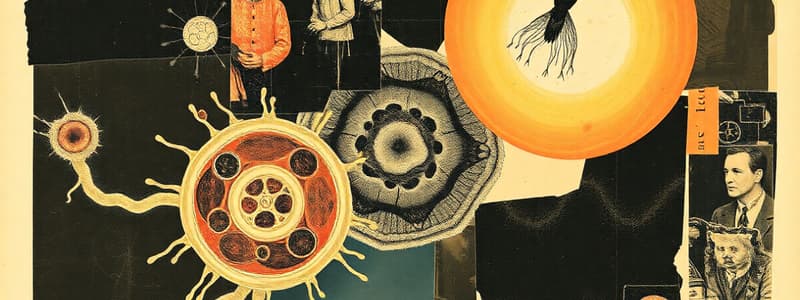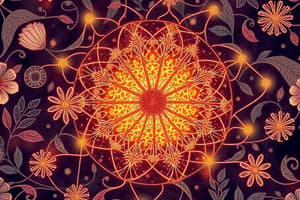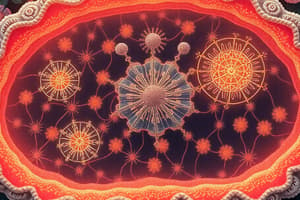Podcast
Questions and Answers
What is the primary role of mitochondria in the cell?
What is the primary role of mitochondria in the cell?
- To extract energy from nutrients and transform it into ATP (correct)
- To transport materials from the nucleus to the cytoplasm
- To maintain the structural integrity of the cell membrane
- To form microtubules for cell division
Which of the following accurately describes the structure of centrioles?
Which of the following accurately describes the structure of centrioles?
- Hollow cylindrical structures that transport proteins
- Pair of cylindrical structures at right angles to each other (correct)
- Filamentous structures that assist in muscle contraction
- Flat discs that serve as energy storage
Which of these functions is NOT associated with microtubules?
Which of these functions is NOT associated with microtubules?
- Forming the structure of cilia and flagella
- Positioning organelles within the cytoplasm
- Transporting cellular materials within the cytoplasm
- Synthesizing ATP from nutrients (correct)
What defines the cristae found in mitochondria?
What defines the cristae found in mitochondria?
What is the primary function of vaults in a cell?
What is the primary function of vaults in a cell?
What is the main reason ATP synthesis is driven in aerobic conditions?
What is the main reason ATP synthesis is driven in aerobic conditions?
During anaerobic conditions, pyruvate is converted into which substance?
During anaerobic conditions, pyruvate is converted into which substance?
What role does the plasma membrane NOT perform?
What role does the plasma membrane NOT perform?
Which component is most abundant in the plasma membrane?
Which component is most abundant in the plasma membrane?
What characteristic of phospholipids contributes to the formation of a lipid bilayer?
What characteristic of phospholipids contributes to the formation of a lipid bilayer?
What provides fluidity and stability to the plasma membrane?
What provides fluidity and stability to the plasma membrane?
How do phospholipids behave within the plasma membrane?
How do phospholipids behave within the plasma membrane?
What energy source is more effective for ATP production in aerobic metabolism?
What energy source is more effective for ATP production in aerobic metabolism?
What is a characteristic of carrier-mediated transport?
What is a characteristic of carrier-mediated transport?
Which of the following scenarios describes facilitated diffusion?
Which of the following scenarios describes facilitated diffusion?
What does saturation in carrier-mediated transport refer to?
What does saturation in carrier-mediated transport refer to?
What is true regarding the specificity of carrier proteins?
What is true regarding the specificity of carrier proteins?
Which of the following best defines vesicular transport?
Which of the following best defines vesicular transport?
Which form of active transport involves the uptake of liquid samples by cells?
Which form of active transport involves the uptake of liquid samples by cells?
What is a primary function of exocytosis?
What is a primary function of exocytosis?
Which type of endocytosis is selectively responsible for the uptake of specific molecules like insulin?
Which type of endocytosis is selectively responsible for the uptake of specific molecules like insulin?
Which of the following processes can enhance phagocytosis during immune responses?
Which of the following processes can enhance phagocytosis during immune responses?
What is meant by micropinocytosis in the context of cellular transport?
What is meant by micropinocytosis in the context of cellular transport?
Which type of transport mechanism does NOT involve the fusion with lysosomes?
Which type of transport mechanism does NOT involve the fusion with lysosomes?
Which statement best describes phagocytosis?
Which statement best describes phagocytosis?
Which of the following is a reason for a cell to perform receptor-mediated endocytosis?
Which of the following is a reason for a cell to perform receptor-mediated endocytosis?
What are microfilaments primarily composed of?
What are microfilaments primarily composed of?
Which statement about intermediate filaments is true?
Which statement about intermediate filaments is true?
What role do inclusions play in the cell?
What role do inclusions play in the cell?
What is intermediary metabolism primarily concerned with?
What is intermediary metabolism primarily concerned with?
How is ATP primarily produced in the cell?
How is ATP primarily produced in the cell?
What function do transport, secretory, and endocytic vesicles serve in the cell?
What function do transport, secretory, and endocytic vesicles serve in the cell?
What is the primary role of ATP in cellular function?
What is the primary role of ATP in cellular function?
What is the smallest cytoskeletal element mentioned?
What is the smallest cytoskeletal element mentioned?
Which of the following is an example of a catabolic process?
Which of the following is an example of a catabolic process?
Which cell component primarily provides mechanical support to microvilli?
Which cell component primarily provides mechanical support to microvilli?
Flashcards are hidden until you start studying
Study Notes
Alcohol
- The liver contains the highest concentration of mitochondria, essential for energy production.
Mitochondria
- Rod or oval-shaped organelles, similar in size to bacteria.
- Enclosed by a double membrane with the inner membrane forming infoldings called cristae.
- Cristae project into the gel-like matrix, creating the intermembrane space.
- Known as energy organelles, extracting energy from nutrients to produce ATP.
- Contain enzymes required for the Citric Acid Cycle (TCA) and Electron Transport Chain.
Centrioles
- Composed of a pair of cylindrical structures oriented at right angles.
- Organize microtubules during cell division to form the mitotic spindle.
- Play a role in the formation of cilia and flagella.
Vaults
- Hollow, octagonal structures acting as transport vehicles for materials between the nucleus and cytoplasm.
Cytoskeleton
Microtubules
- Long, hollow tubes made of tubulin that maintain cell shape and facilitate complex movements.
- Serve as highways for the transport of vesicles and are vital for positioning organelles.
Microfilaments
- Smallest cytoskeletal elements made up of intertwined actin chains.
- Facilitate muscle contraction and amoeboid movement, and provide structure to microvilli.
Intermediate Filaments
- Thread-like, irregular filaments that resist mechanical stress.
- Contribute strength in multiple proteins, such as keratin found in hair.
Cytosol
- Often referred to as cell gel; it houses enzymes for metabolic reactions.
Intermediary Metabolism Enzymes
- Facilitate reactions for degradation, synthesis, and transformation of small organic molecules.
Transport, Secretory, and Endocytic Vesicles
- Membrane-bound products formed within or engulfed by the cell for transport or storage.
Inclusions
- Structures like glycogen granules and fat droplets that store excess nutrients.
Cellular Metabolism
Intermediary Metabolism
- Encompasses a range of chemical reactions in the cell involving small organic molecules, including sugars, amino acids, and fatty acids.
- Subcategories include anabolic (synthesis) and catabolic (degradation) processes.
ATP Production
- ATP (Adenosine TriPhosphate) is the primary energy currency in the body, derived from carbon bonds in food.
- Energetic processes utilize a H+ gradient to drive ATP synthesis by ATP synthase.
Plasma Membrane
- Composed of a phospholipid bilayer with proteins and some carbohydrates, serving as a barrier and communication interface.
- Separates intracellular and extracellular compartments and selectively permits molecular movement.
Structure and Composition
- Phospholipids are the most abundant lipids, each with a hydrophilic head and hydrophobic tails.
- Over a billion phospholipids are contained within a typical human plasma membrane.
Assisted Membrane Transport
- Mechanisms for large or poorly lipid-soluble molecules to cross the plasma membrane include carrier-mediated transport and vesicular transport.
Carrier Mediated Transport
- Involves proteins that change shape to move substances across the membrane.
- Two forms: passive (facilitated diffusion) and active transport, requiring energy expenditure.
Endocytosis
- Types:
- Pinocytosis (cell drinking) for non-selective fluid uptake.
- Receptor-Mediated Endocytosis for selective intake of specific molecules.
- Phagocytosis (cell eating) specific to specialized cells for large multimolecular particles.
Exocytosis
- The reverse of endocytosis, used for the secretion of polar molecules and for membrane composition changes.
Studying That Suits You
Use AI to generate personalized quizzes and flashcards to suit your learning preferences.




